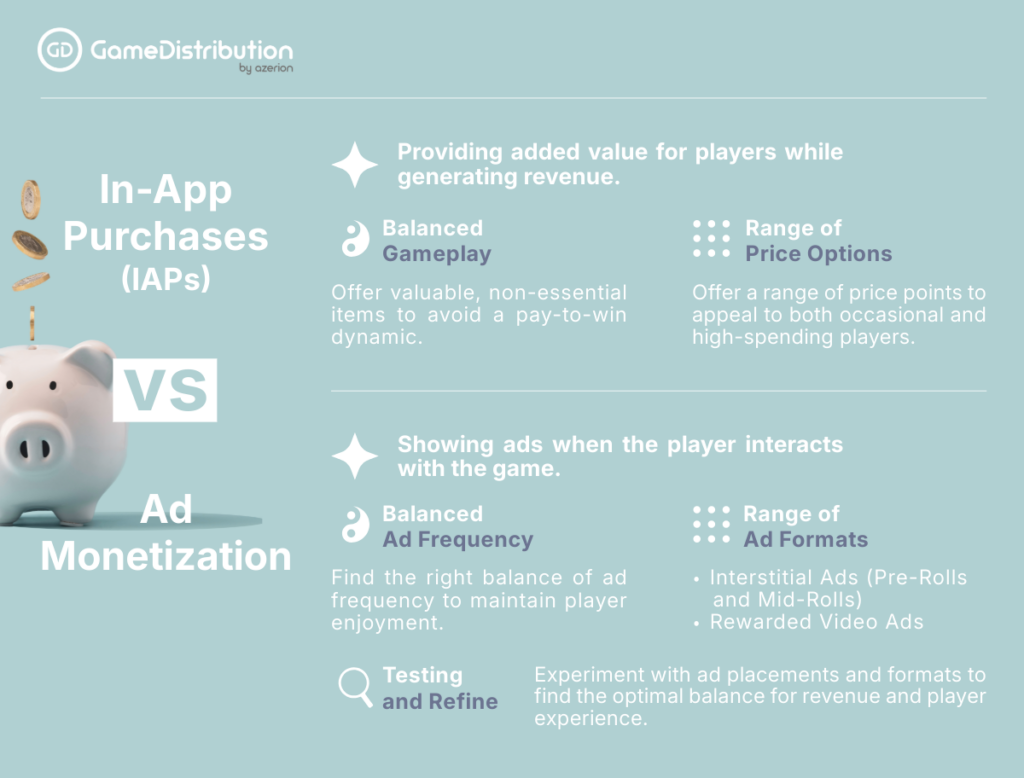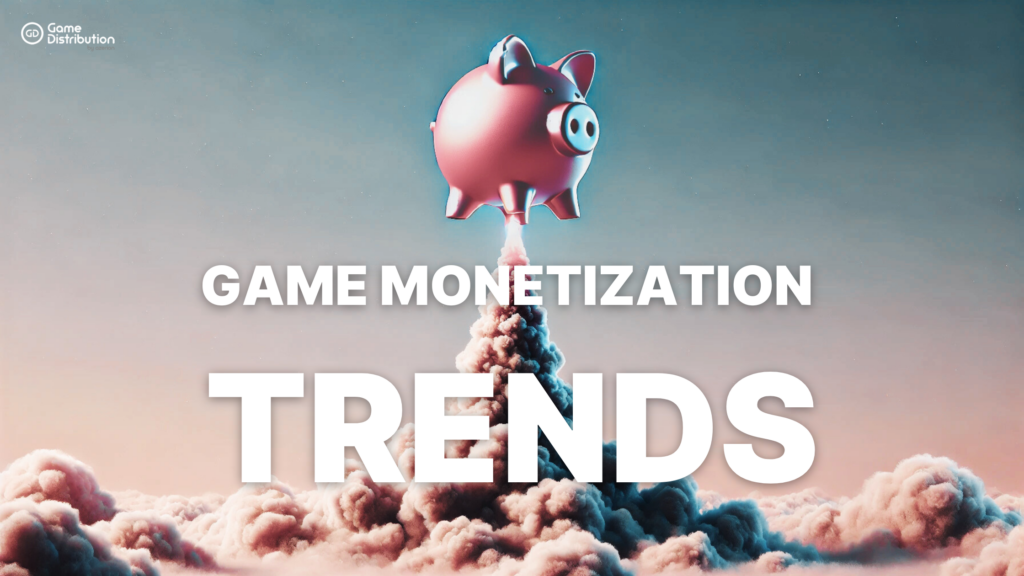Choosing the right game monetization strategy is essential for success as a game developer, yet generating revenue while keeping players engaged and satisfied is a challenging business. Over the years, HTML5 game monetization has evolved significantly due to advances in technology, shifts in player behavior, and changing market trends. This makes implementing effective monetization strategies all the more crucial for developers aiming to achieve long-term success in the highly competitive gaming industry.
Section 1: Understanding Game Monetizatization
What is Game Monetization?
Game monetization refers to the practice of making money from a game and the various methods and strategies that can be used to achieve this. In HTML5 game monetization, the key is converting players’ time and attention into financial returns. There are multiple models for doing so, including in-app purchases (IAPs), advertisements, and subscriptions. Each model comes with its own set of benefits and challenges. This is what makes it so important for developers to select the right strategy based on their target audience and game design.
Types of Game Monetization Models
There are several game monetization strategies available to developers and, as mentioned above, each one comes with unique advantages and challenges. Understanding these models is crucial for selecting the most effective approach:
-
In-App Purchases (IAPs)
In-app purchases (IAPs) are a popular and effective game monetization method. This model enables players to buy virtual goods, currencies, or other upgrades directly within the game. These types of microtransactions – small purchases made by players – are a common form of IAP.
For instance, developers can create different skins or outfits so that players can adapt their character to reflect their personal style. They can also offer functional upgrades that improve the player’s experience of the game. A good example of this can be found in Golden Frontier, where players can purchase extra lives or boosters to accelerate their progress.
-
Ad Monetization
Ad monetization involves displaying advertisements to players in various formats, such as banner ads, interstitial ads, midroll ads, and rewarded video ads. This strategy is particularly effective in HTML5 game monetization, especially for games that are designed to be distributed through browsers. If the studio chooses this method, we recommend implementing all available formats within the game.
Please note: For mobile games that are mainly monetized through in-app purchases (IAPs), transitioning to web-based monetization with ads requires a different approach. In this case, shifting your IAPs system to a rewarded ads model is key. To do this effectively, you cannot simply replace one with the other – the entire mechanic will need to be restructured. When done strategically, however, the results of this move can be impressive. A great example of this approach can be found in Mergest Kingdom.
-
Subscription Model
Subscription-based monetization offers players continuous access to premium content in exchange for a recurring fee. This model works well for games that provide regular content updates and/or exclusive features. While subscription models offer a predictable revenue stream, they also require developers to consistently deliver value to retain their subscribers.
The Importance of Choosing the Right Game Monetization Strategy
Selecting the right game monetization strategy is essential. It allows developers to maximize their game’s revenue potential while also ensuring a positive player experience. Choosing the wrong approach can lead to player frustration and reduced engagement, resulting in lower revenue. Developers should carefully consider key factors such as the game’s genre, their target demographic, and the competitive landscape.
For example, casual HTML5 games with a broad and diverse audience may benefit more from ad monetization and in-app purchases (IAPs). Niche or hardcore games, on the other hand, might find more success with subscription-based models. In all cases, the goal is to strike the right balance between monetization and gameplay, keeping players happy while also generating consistent revenue.
For HTML5 game developers aiming to reach an audience through browsers, the two most commonly used strategies are in-app purchases (IAPs) and ads. Let’s explore these strategies in detail and examine how to monetize games more effectively.
Section 2: Popular Browser Game Monetization Strategies
For HTML5 game developers aiming to reach an audience through browsers, the two most commonly used strategies are in-app purchases (IAPs) and ads. Let’s explore these strategies in detail and examine how to monetize games more effectively.

In-App Purchases (IAPs)
In-app purchases (IAPs) have become a cornerstone of game monetization for many HTML5 games. The success of IAPs lies in their ability to offer value to players while generating revenue for developers. They should enhance the gaming experience without compromising the enjoyment of non-paying players.
To use IAPs successfully, developers must make sure that the items offered for payment are valuable but not essential to gameplay. It is important to avoid creating a pay-to-win situation, as this can erode the players’ trust in the game and its creators.
We also recommend creating a range of price points at which players can buy (sets of) items. This allows the game to appeal to occasional spenders, while also catering to those players who are interested in making larger, more significant purchases.
Ad Monetization
Ad monetization is another popular strategy that casual HTML5 game developers use to generate income. It involves showing ads when the player interacts with the game. This game monetisation strategy can be very effective, as long as there is a good balance between the ad frequency and the player’s enjoyment of the game.
There are several formats in which ads can be displayed. This includes interstitial ads that are shown during natural breaks in the game, and banner ads. Another ad format that has proven particularly popular in recent years is the rewarded video ad. These are ads that players can choose to watch in exchange for in-game rewards, such as extra lives or in-game currency.
Thoughtful use of rewarded ads can actually enhance the player’s experience of the game. Rather than forcing a disruption to the gameplay, rewarded ads invite the player to make an active choice: engage with the ad to receive something of value, or skip the ad and lose the reward. Games like Crossy Road show how successfully integrated rewarded ads lead to consistent revenue without negatively impacting player engagement.
It should be noted that ad monetization always requires careful attention to ad placement and frequency. Too many ads can disrupt the flow of the game and cause players to feel frustrated. Too few ads can result in missed revenue opportunities. We recommend that developers experiment with different formats and placements to find the optimal balance for each game, maximizing revenue without compromising the player experience.
Section 3: Emerging Trends in Game Monetization

Hybrid Model of Game Monetization
The hybrid model of game monetization combines the advantages of both advertising and in-app purchases (IAPs). It can also include combinations of IAPs and subscriptions, or ads and subscriptions, depending on the game’s design.
Combining Ads and IAPs
Typically, studios implement interstitial ads and mid-rolls while integrating IAPs into the game’s economy. The game might offer free access supported by ads, with the option to remove ads by purchasing premium content via IAPs. This flexible approach allows developers to keep up with game monetization trends while ensuring a positive player experience. The rise of hybrid models reflects the increasing complexity of the gaming landscape and the need for adaptive strategies to meet evolving market conditions.
Other Hybrid Monetization Options
Hybrid models are always about experimentation. They help to map out new and innovative approaches. For example, some games now offer subscription options alongside in-app purchases (IAPs) and ads. This allows players to enjoy an ad-free experience and access exclusive content for a monthly fee.
The combination of these game monetization strategies broadens revenue streams for developers and supports a more sustainable business model. This is particularly effective when monetizing HTML5 games, where the different revenue streams complement each other.
A potential drawback of combining monetization strategies that require a login is that players may not always be willing to register or log in.
The Role of Data in Game Monetization
Data plays a crucial role in shaping game monetization strategies. Developers now have access to extensive data on player behavior, preferences, and spending habits. This information is used to optimize monetization efforts, helping to identify the most effective strategies, pinpoint player drop-off points, and improve engagement and retention.
Data-driven monetization enables personalized experiences. For instance, some games use data to offer targeted promotions or discounts based on a player’s in-game activity. This personalized approach increases the likelihood of conversion and enhances overall player satisfaction.
Additionally, data helps developers spot emerging monetization trends, so that they can adjust their strategies in real time. By staying responsive to shifts in player behavior and market dynamics, developers can remain competitive and continue growing their revenue over time.
Ethical Considerations in Game Monetization
As game monetization strategies evolve, discussions around the ethical implications of these practices are increasing. Developers must ensure that the methods used to generate revenue are fair and respectful to players.
For instance, the use of “loot boxes” and other gambling-like mechanics has been criticized for promoting addictive behavior. Aggressive ad monetization can also harm the player experience if not handled carefully. To avoid these issues, developers should focus on creating transparent and fair monetization strategies that respect players’ time and money.
By adopting ethical monetization practices, developers can build trust with their players. This leads to a more positive and sustainable gaming environment, supporting long-term success.
Conclusion
Effective game monetization strategies are crucial to the success of casual games. To secure their income, developers must have a good understanding of various monetization models, from in-app purchases to ad-based strategies and subscription services.
For HTML5 games, ad-based monetization remains a core strategy. However, this method comes with unique challenges that require thoughtful consideration. Striking the right balance between ads and user experience is key to ensuring both player satisfaction and revenue growth.
By following best practices, developers can create sustainable monetization models that support long-term success. This includes testing and optimizing strategies, balancing user experience with revenue goals, and adapting to player feedback and industry trends.
As the gaming industry continues to evolve, staying informed and flexible is essential. Developers who are able to do this will thrive in this dynamic landscape. For more insights and updates on game monetization strategies, follow GameDistribution’s blog.






